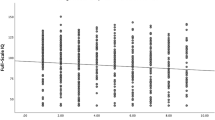Abstract
Longitudinal comparisons were made of intelligence and developmental quotient (IQ/DQ) scores for three age groups of 70–72 autistic children aged 2 to 3, 4 to 5, and 6 to 7 years at initial assessment and reassessed at least 2 years later. Stability and predictability over a mean follow-up period of 5 years were related to age, developmental level, and test used at initial assessment. IQ/DQs during preschool years were quite stable and predictive of later IQ scores, except when early scores on the Bayley Scales of Mental Development were compared with later scores on performance or nonverbal tests. As for other populations, predictability for young autistic children was strongest when the same test was used at both assessments, and when children were 4 years or older at initial assessment.
Similar content being viewed by others
References
Arthur, G. (1952).The Arthur adaptation of the Leiter International Performance Scale. Chicago: The Psychological Service Center Press.
Bayley, N. (1969).Manual for the Bayley Scales of Infant Development. New York: Psychological Corp.
DeMyer, M. K., Barton, S., Alpern, G. D., Kimberlin, C., Allen, J., Yang, E., & Steele, R. (1974). The measured intelligence of autistic children.Journal of Autism and Childhood Schizophrenia, 4, 42–60.
DeMyer, M. K., Barton, S., DeMyer, W. E., Norton, J. A., Allen, J., & Steel, R. (1973). Prognosis in autism: A follow-up study.Journal of Autism and Childhood Schizophrenia 3, 199–245.
Doll, E. A. (1965).Vineland Social Maturity Scale. Circle Pines, MN: American Guidance Service.
Freeman, B. J., Ritvo, E. R., Needleman, R., & Yokota, A. (1985). The stability of cognitive and linguistic parameters in autism: A five-year prospective study.Journal of the American Academy of Child Psychiatry, 24, 459–464.
Gillberg, C., & Steffenburg, S. (1987). Outcome and prognostic factors in infantile autism conditions: A population-based study of 46 cases followed through puberty.Journal of Autism and Developmental Disorders, 17, 273–288.
Hays, W. L. (1963).Statistics for the social sciences. New York: Holt, Rinehart & Winston.
Hindley, C. B., & Owen, C. F. (1978). The extent of individual changes in IQ for ages between 6 months and 17 years, in a British longitudinal sample.Journal of Child Psychology and Psychiatry, 19, 329–350.
Kopp, C. B., & McCall, R. B. (1982). Predicting later mental performance for normal, at risk, and handicapped infants. In P. B. Baltes & O. G. Brim, Jr. (Eds.),Life-span development and behavior (Vol. 4, pp. 33–61). New York: Academic Press.
Lockyer, L., & Rutter, M. (1970). A five to fifteen-year follow-up study of infantile psychosis: IV. Patterns of cognitive ability.British Journal of Social and Clinical Psychology, 9, 152–163.
Lord, C., & Schopler, E. (1985). Differences in sex ratios in autism as a function of measured intelligence.Journal of Autism and Developmental Disorders, 15, 185–193.
Lord, C., & Schopler, E. (1988). Intellectual and developmental assessment of autistic children from preschool to schoolage: Clinical implications of two follow-up studies. In E. Schopler & G. B. Mesibov (Eds.),Diagnosis and assessment in autism (pp. 167–181). New York: Plenum Press.
Lord, C., & Schopler, E. (1989). Stability of assessment results of autistic and nonautistic language-impaired children from preschool years to early school age.Journal of Child Psychology and Psychiatry.30, 575–590.
Lord, C., Schopler, E., & Revicki, D. (1982). Sex differences in autism.Journal of Autism and Developmental Disorders, 12, 317–330.
Lovaas, O. I. (1987). Behavorial treatment and normal educational and intellectual functioning in young autsitic children.Journal of Consulting and Clinical Psychology, 55, 3–9.
Parks, S. L. (1983). The assessment of autistic children: A selective review of available instruments.Journal of Autism and Developmental Disorders, 13, 225–268.
Rutter, M. (1978). Diagnosis and definition of childhood autism.Journal of Autism and Developmental Disorders, 8, 139–161.
Rutter, M. (1985a).A clinician's guide to child psychiatry (pp. 48–78). New York: Free Press.
Rutter, M. (1985b). The treatment of autistic children.Journal of Child Psychology and Psychiatry, 26, 193–214.
Rutter, M. & Lockyer, L. (1967). A five to fifteen year follow-up study of infantile psychosis: I. Description of sample.British Journal of Psychiatry, 113, 1169–1182.
Sattler, J. M. (1982).Assessment of children's intelligence and special abilities. Boston Allyn & Bacon.
Scheffé, H. (1953). A method for judging all contrasts in the analysis of variance.Biometrika, 40, 87–104.
Schopler, E. (1987). Specific and nonspecific factors in the effectiveness of a treatment system.American Psychologist, 42, 376–383.
Schopler, E., & Reichler, R. J. (1971). Problems in the developmental assessment of psychotic children.Excerpta Medica International Congress Series, 274, 1307–1311.
Schopler, E., Reichler, R. J., & Renner, B. R. (1986).The Childhood Autism Rating Scale (CARS) for diagnostic screening and classification of autism. New York: Irvington Publishers.
Shah, A., & Holmes, N. (1985). The use of the Leiter International Performance Scale with autistic children.Journal of Autism and Developmental Disorders, 15, 195–204.
Stutsman, R. (1931). Guide for administering the Merrill-Palmer Scale of Mental Tests. In L. M. Terman (Ed.),Mental measurement of preschool children (pp. 139–262). New York: Harcourt, Brace & World.
Terman, L. M., & Merrill, M. A. (1973).Stanford-Binet Intelligence Scale Form L-M. Boston: Houghton-Mifflin.
Waterhouse, L., & Fein, D. (1984). Developmental trends in cognitive skills for children diagnosed as autistic and schizophrenic.Child Development, 55, 236–248.
Wechsler, D. (1974).Wechsler Intelligence Scale for Children-Revised. New York: Psychological Corp.
Author information
Authors and Affiliations
Additional information
This research was funded in part by grants from the Natural Sciences and Engineering Research Council of Canada and the Alberta Heritage Foundation for Medical Research to the first author. Preliminary results from this project were presented at the annual TEACCH Conference on Autism in Durham, North Carolina, in May 1986.
Rights and permissions
About this article
Cite this article
Lord, C., Schopler, E. The role of age at assessment, developmental level, and test in the stability of intelligence scores in young autistic children. J Autism Dev Disord 19, 483–499 (1989). https://doi.org/10.1007/BF02212853
Issue Date:
DOI: https://doi.org/10.1007/BF02212853




